Strategic Transformation, develop Core Competencies & Centres of Excellence

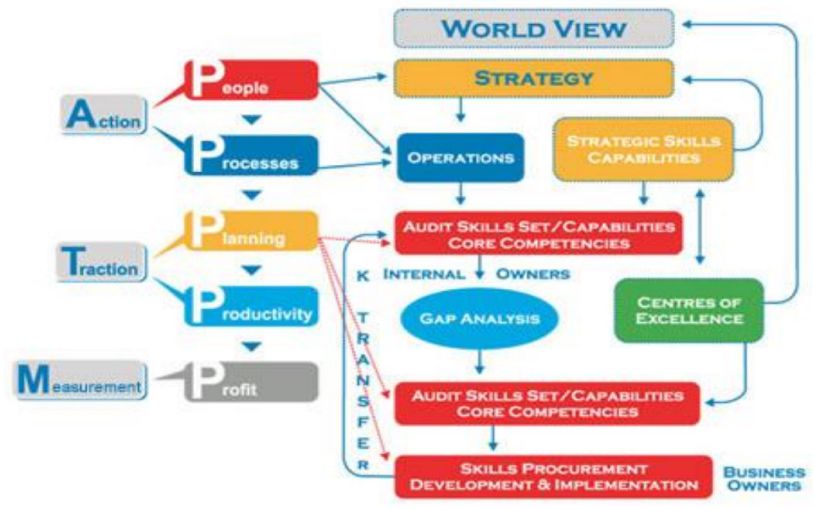
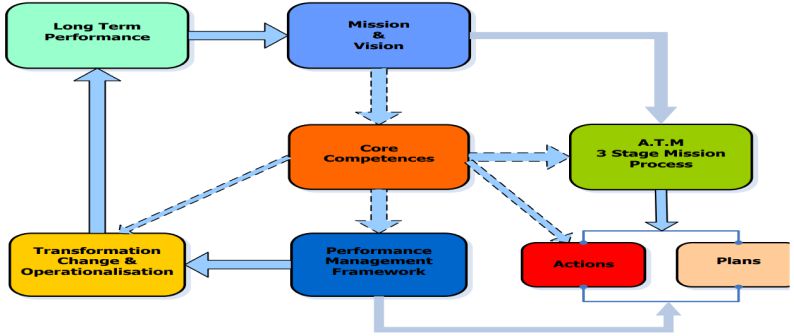
The A.T.M view of the Business System has Seven Key Elements
Dictionary definitions of the term ‘strategy’ vary – but most have a distinctly militaristic bent, referring to “Generalship” and the “art or science of the planning or conduct of a war”. The Collins English Dictionary, however, suggests that a strategy can also be “a particular long-term plan for success, especially in business or politics” – and in essence it is that definition that has underpinned traditional management thinking. In our view, however, such a generic definition – while undoubtedly accurate in the sense of stating the obvious – is no longer adequate for knowledge-intense 21st-Century organisations. At A.T.M Strategic Management Consulting Limited we believe the definitions below, expounded by a range of respected management experts, better reflect the true breadth and importance of strategy in the building of lasting business success.
”What business strategy is all about is, in words, competitive advantage. The sole purpose of strategic planning is to enable a company to gain, as efficiently as possible, a sustainable edge over its competitors. Corporate Business Strategy thus implies an attempt to alter a company’s strength relative to that of its competitor in the most efficient way.”Kenichi Ohmae – From “The Mind of the Strategist”
“Competitive strategy is about being different. It means deliberately choosing a different set of activities to deliver a unique mix of value.”
Prof. Michael Porter – On Competition
“Strategy evolves inside the organisation – not from its future environment. Strategy is a deeply engrained and continuing pattern of management behaviour that gives direction to the organisation – not a manipulable and controllable mechanism that can easily be changed from one year to the next. Strategy is a non-rational concept stemming from the informal values, tradition, and norms of behaviour held by the firm’s managers and employees – not a rational, formal, logical, conscious and predetermined thought processes engaged in by top executives. Strategy emerges out of the cumulative effects of many informal actions and decisions taken daily over the years by many employees – not a “one short” statement developed exclusively by top management for distribution to the organisation.”
Tom Peters, “Strategy Follows Structure”, California Management Review, 1998
Knowledge-based strategy means acquiring, developing, renewing, and managing a firm’s core competencies and intellectual assets effectively. The firm can exploit those competencies and intellectual assets to their full potential, so that it can leverage those core competencies and intellect to produce ‘best in the world’ products and services that can give the firm sustainable growth, profitability, and long-term competitive advantage.
To achieve these objectives the firm: first, must acquire essential knowledge, skills and capabilities (intellectual assets). Second, it must develop, enhance, retain, and manage its knowledge base. And third, it must use its knowledge base effectively (intellectual assets) to create and develop necessary core competencies and capabilities. And finally, it must leverage those core competencies and capabilities to produce the ‘best in the world’ products and services that would provide the firm with a long-term competitive advantage.”
Anwar Masih, A.T.M Strategic Management Consulting Limited ©, 1999-2015
At face value these definitions may seem diverse. At A.T.M Management Consulting, however, we believe that, taken collectively, these ideas encapsulate the true meaning and importance of strategy in the knowledge-based economy. The key to our thinking is the belief that firms should focus ruthlessly on what they are best at – requiring an honest and even brutal assessment of both their strengths and weaknesses. As the Consultancy’s Anwar Masih puts it: “Knowledge-based strategy also implies that the firm must deconstruct its generic Value Chain, so that activities in which the firm is not “best in the world” performing it, these can be outsourced to a third-party supplier who is “best in the world” at performing that particular activity of the value chain.” This, however, must of course be subject to the transaction cost of that activity being substantially lower than that if the firm performed it internally.
Strategy offers a competitive advantage that is not achievable by operational efficiency and effectiveness alone. “While operational efficiency leads to cost advantage that is easily copied and imitated by the competition,” explains Prof. Michael Porter, “Strategy is about firm’s policies and tactics becoming deliberately different than the competition to allow the firm to seek and secure competitive advantage.” As Prof. Gary Hamel puts it in his book ‘Competing for the Future’, operational efficiency is concerned with how the company competes today, whereas strategy is concerned with how the company will compete in tomorrow’s competitive market.
Strategy is about trying to meet the needs of various stakeholders in the company’s business and being accountable to those stakeholders by behaving responsibly. Those stakeholders include any parties that have an interest or stake in the success, or performance, of the business. In other words stakeholders are the parties who stand to benefit from the company’s successful operations – and as well as owners (or shareholders) and direct employees they can be deemed to include suppliers and customers, local communities, trade associations, government, educational institutes and even society at large.
Meeting the needs of such diverse groups can be a difficult task as stakeholders often have a conflicting interest. The benefits of having a strategically-led business are still essentially the same as described by Prof. Porter and Prof. Gary Hamel more than a decade ago. However, there are enormous numbers of examples that demonstrate the existing strategy development frameworks, models and methods are inefficient and inadequate for developing strategies for knowledge-intense industries. That is because the existing strategy development tools, frameworks, models and methods focus on developing strategies around the firm’s fixed assets such as buildings (location), raw materials and technology. They largely ignore the firm’s knowledge-based and intellectual assets. Therefore, the challenge we now face when dealing with any given firm is to propose a framework that would help it develop strategies around its knowledge and intellectual assets rather than merely its fixed assets.
Looking back at how the strategic management field has evolved since its formal recognition in the 1950s, it is possible to track successive trends of dominant thinking. Prof. Robert M. Grant (Contemporary Strategy Analysis, 2007) and Prof. John McGee, Prof.Howard Thomas, and David Wilson (Strategy Analysis & Practice, 2005) have the identified prominent strategy themes for each decade.
1950s – Financial Budgeting (DCF-based capital budgeting & financial control through operating budgets).
1960s – Corporate Planning (Mid-term economic forecasting, formal corporate planning, diversification, quest for synergy, and creation of corporate planning departments).
1970s – 1980 – Strategy as Positioning (Industry analysis, market segmentation, the ‘experience curve’, PIMS analysis, planning business portfolios).
1990 – Strategy as Competitive Advantage (Analysis of resources & capabilities, shareholder value creation/maximisation, re-structuring & re-engineering, and strategic alliances between partners to share risk & reward, total quality management (TQM),business process management, paperless-office, etc.)
2000 – Strategy for the New Economy (Strategic innovation & management, new business models E-Business/E-Commerce, and mass deployment of disruptive technologies such as Internet, virtual Supply-chain, etc.).
2000 – Strategy for the New Economy (Strategic innovation & management, new business models E-Business/E-Commerce, and mass deployment of disruptive technologies such as Internet, virtual Supply-chain, etc.).
2007 – Current & Future – 21st Century Strategy Themes (Corporate governance & ethics, strategic leadership, competing for standards, globalisation & emerging markets (Brazil, China, India), environmental issues, scarcity of energy resources, industry-wide networks, managing strategic change, managing risk & uncertainty, development of strategic skills & capabilities, strategic knowledge management, financial engineering/private equity/M&A, etc.)
Trawling through the evidence on successes & failures of strategy development & implementation over the past 60-years, we have found a pretty patchy record of success. We observed that while each decade had different strategic management themes to
address the prominent challenges of the time, the basic problems and issues which led to the demise or failure of each theme or model were very similar to what most organisations encounter today. As described by McKinsey’s (McKinsey Quarterly, 2007, Issue
Number 3), most organisations which have either had, or have, a strategy have had no path for its execution, nor the essential strategic skills, capabilities & core competencies required for its meaningful implementation.
This was expanded upon by Prof. Richard Rumelt who wrote (in McKinsey Quarterly, 2007, Issue Number 3) of a widespread misperception & misunderstanding amongst executives as to what having a strategy actually means.
Prof. Rumelt points out that most “corporate strategic plans have little to do with strategy. They are simply a three-year or five-year rolling resource or spending budget plans and market share-projection & revenue forecasting. Calling it Strategic Planning or
Strategy Development creates false expectations that the exercise will produce a coherent strategy.
Prof. Richard Rumelt, UCLA Anderson School of Management
In our view, having a “grand vision & strategy” without committing to its execution is, at best, equivalent to not having it at all. Existing in theory, but not followed-through, such disembodied strategy statements merely cause an unnecessary distraction and waste valuable financial resources. That is why A.T.M’s strategy development & implementation approach studiously avoids management fads and the latest strategy bandwagon in favour of our unique 3-stage strategy development proposition.
Designed to address the 21st Century challenges head-on, our approach is the antithesis of the well-meaning but pointless strategy statements that so often collect dust in HQ filing cabinets while the rest of the organisation carries on regardless or even oblivious to their existence.
Instead we put people at the heart of the strategy development process, ensuring corporate-wide engagement with the strategy and an understanding that it matters that it is followed through at every level. Above all, our approach is an integrated one – ensuring that an organisation has all the necessary strategic skills, capabilities & core competencies needed to develop, execute, implement, maintain and renew the corporate & business strategy that we develop & implement.
Leading management guru Prof. James Brian Quinn has argued that existing strategies are out-of-date and inadequate for addressing 21st Century business needs. He was referring to existing strategic management frameworks such as Porter’s Five Forces, The Boston Matrix, Scenario Planning, and PIMS model.
At A.T.M Strategic Management Consulting Limited we agree these strategy tools, frameworks, and models are inefficient and inadequate for strategizing in 21st Century knowledge-based industries. That is because they predominantly focus on the firm’s fixed assets, the legacy of the pre-occupation with mass-production and economies-of-scale, and are financially-oriented.
Prof. C.K Prahalad and Prof. Gary Hamel (Leadership & Management in 21st Century, Collective Edition, 2000), point out that in most organisations today strategy development & strategic planning is in a state of confusion and turmoil because of the speed and dynamism of today’s markets. Once top management’s ‘brilliant strategy’ has finally been drawn up in the company’s comfortable headquarters, everything has already changed by the time it reaches its subsidiaries & frontline management. As Prof. Hamel puts it,
“the bottleneck is at the top of the bottle.”
Prof. Prahalad and Prof. Hamel go on to argue that some of the critical challenges posed in strategy development are:
All of these 21st Century challenges are making the strategy development and implementation life-cycle shorter and shorter. Organisations must therefore speed up the process developing a corporate-wide Strategy Development Process which engages talented people across the whole business rather than developing ad-hoc strategies at corporate headquarters level.
In our view, therefore, the fundamental challenges to strategy development mean rethinking the whole strategy development process.
In our experience, most organisations’ frontline management and staff don’t have the relevant strategic skills, capabilities and core competencies required to implement corporate/business strategies correctly. The time that it takes for the necessary skills to be
acquired often induces significant time-lapses which, in turn, kill the strategic initiatives stone dead because agile competitors may already have moved quickly ahead with powerful first-mover advantage.
That is why we believe the development and implementation of strategy should become an inclusive corporate-wide activity rather than a remote HQ responsibility carried out in isolation. In our view, corporate-wide strategy development initiatives can only truly work after people across the organisation have developed the essential strategic skills & capabilities required for the strategy’s swift development and implementation.
In short, instilling those skills across the wider organisation is the giant leap required in today’s business environment
To be a leader in today’s globally competitive market requires two attributes, identified by the late Prof. Peter Doyle (Marketing & Strategy”, 1998) as ‘ambitious strategic intent’ and ‘outstanding core competencies and capabilities’.
Strategic intent refers to the pure dedication and intense commitment of top management to focus the resources and energies of the organisation in pursuit of a specific world-leading position. Examples of companies that have thrived on such ambitious strategic intent include Microsoft, Intel, Cisco, Dell, Toyota, Honda, and Sony. These organisations were all very much built on their founders’ pure dedication and commitment, complete with ambition and clarity of objectives achieving in the process what we refer to as ‘best-in-the-world’ status.
Leading experts have described strategic intent as an “animated dream” (Prof. Gary Hamel & Prof. C.K. Prahalad, “Competing for the Future”, Harvard Business School Press, 1997) – and for good reason. Strategic intent, after all, can be viewed as strategy’s answer to an architectural keystone – the central stone at the top of an arch or dome which essentially supports the whole structure. Just as a keystone’s pivotal position at the apex of a physical structure keeps the construct standing, strategic intent points the way beyond the present to the future.
Above anything it is ambitious and compelling strategic intent that provides the emotional and intellectual energy needed to begin the process of effective strategy development and implementation.
Prof. Michael Porter points out in his latest book (“On Competition”) that, contrary to conventional wisdom, cost advantage is no longer the key determinant for developing a competitive advantage because nowadays competitors can easily overcome that gap. That means that competitive advantage must now come from the firm’s core competencies, know-how (knowledge), and intellectual assets. In today’s business world only these knowledge-based attributes can secure success in the development of highly differentiated and “best-in-the-world” products and services that are the ultimate
hallmarks and indeed bulwark of “Built-to-Last” Enterprises.
Our 3-Stage Strategy Development Proposition & Progressive Transformation Process is designed to address the 21st Century strategic challenges head-on by:
Our proposition is strategically-focused – developing/creating core competences, strategies and “Centres-of-Excellence” fit for the knowledge-based “Built-to-Last Culture”
Our aim is to give your organisation the route-map to become a Strategic Intelligent Enterprise; one that can adapt to changing circumstances by ‘Learning-at-Speed’ and stay ahead of the competition by a process of continuous improvement & constant regeneration.
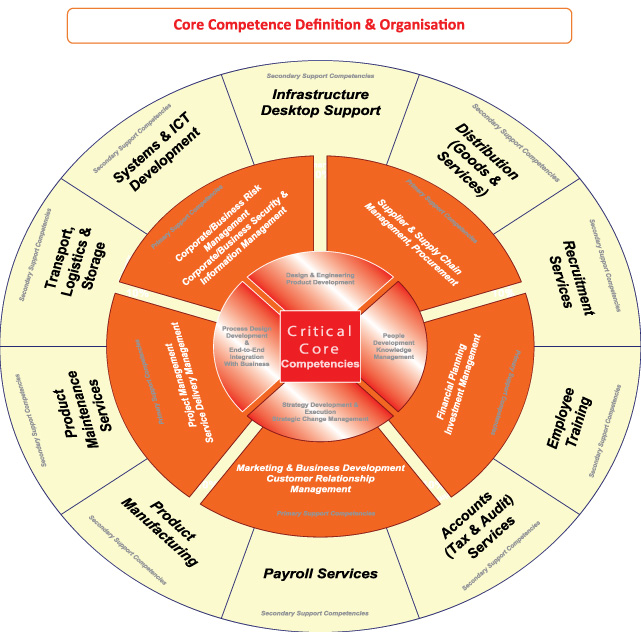
Through our Ten year research & experience designing, developing, and testing Core Competencies, we have categorized firms’ Core Competencies into three distinct categories as follows:
1- Critical Strategic Core Competencies (High-level Strategic Capabilities) – These are essential to developing & maintaining company/firm’ competitive advantage – they link customer benefits to company/firms’ capabilities. They are unique to the company in one of three following ways:
2- Primary Support Competencies (Low-level Strategic Capabilities) – are “co-specialised” with Critical Competencies designed to be integrated with the company/firm’s Critical Competencies in either, Design, Construction, Delivery or post-sale service Support/maintenance. They are unique to the company in one of three following ways:
3- Secondary Support Competencies (Non –Strategic Capabilities) – are generalist type skills/capabilities required to support during the Design, Construction or Delivery of the company/firm’ Critical or Secondary competencies. They are only unique to the company in the way it can integrate it into its Critical or Primary capabilities/competencies development during the either the Design, Construction, Delivery, or post-sale service Support/maintenance:
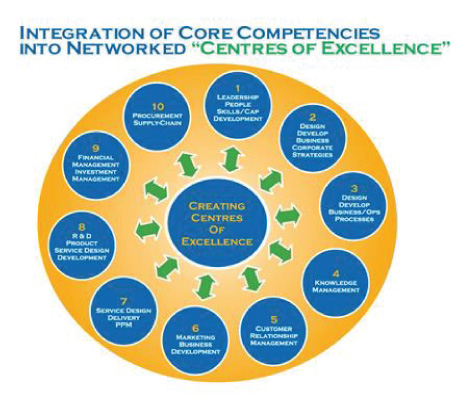
At ATM we believe that core competences and the associated issues of knowledge and knowledge management together with the salience of people in
the practical running of organisations are central to a practical understanding of business strategy and its implementation. We call the process of developing these Core Competencies the “Progressive Transformation Process”.
Importance of Developing & Integrating Core Competencies
At A.T.M Strategic Management Consulting we agree with Prof. James B. Quinn’s assessment (Intelligent Enterprises, 1992) that a firm should focus its strategic investment, management attention, and knowledge & intellectual resources on those Core Competencies where it can achieve and maintain the “best-in-the-world” status benchmark against its competitors.
That means the company must:
A series of guidelines can be used to assess what constitutes a valuable core competence, knowledge-asset or valuable skill/capability
Key to A.T.M’s thinking is the belief that firms should focus ruthlessly on what they are best at – requiring an honest assessment of both their strengths and weaknesses. If, having looked at its activities, a company concludes that in some areas it will either never achieve ‘best in the world’ status – or that status, though once achieved, cannot possibly be maintained – it must consider outsourcing those activities.
At A.T.M, Anwar Masih puts it that:
“Knowledge-based strategy also implies that the firm must deconstruct its generic value chain, so that activities at which the firm is not “best in the world” can be outsourced to a third-party supplier who is “best in the world” at performing that particular activity of the value chain.”
This, however, of course must be subject to the transaction cost of that activity being substantially lower than that if the firm performed it internally.
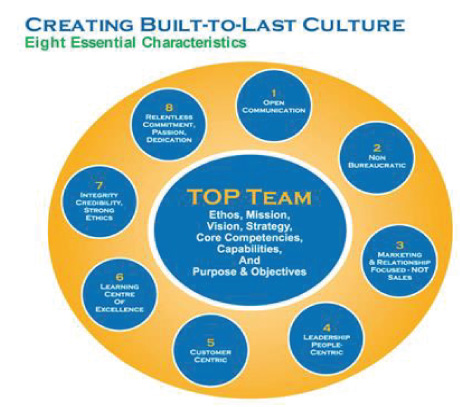
The struggle to create Core Competencies needs to focus on the development of essential strategic skills & practical capabilities in your workforce. In Strategic Intelligent Enterprises these skills lay the foundations for “Centres-of-Excellence” from which superior-performance is derived. At A.T.M we call the process of developing these Core Competencies the “Progressive Transformation Process”.
All of A.T.M’s experience and research has led us to the conclusion that eight essential characteristics are required to create “Built-to-Last” organisations. We have found clear evidence that companies that adapt and encourage these characteristics have constantly outperformed their rivals because they strategize around their knowledge base rather than fixed assets. In so doing they have created nonbureaucratic organisational cultures that facilitate the free exchange of knowledge and an environment in which people are given autonomy for decision-making and are rewarded for sharing their knowledge rather than just having it. These companies typically promote open communication throughout the organisation and a status-less culture where people are rewarded for value contribution through their knowledge and intellect rather than their management status.
Although what Prof. Peter Senge described as ‘reflective openness’ (“The Fifth Discipline”, HBR, 1998) undoubtedly benefits significantly from aptitudes for reflection and inquiry as well as knowledge, openness itself is a far more profound and beneficial characteristic for a business to aspire to than the other attributes alone.
In a sense ‘openness’ goes beyond personal qualities, skills and practices because it is about the very relationship an individual or organisation has with others. While encompassing a range of definable intellectual attributes, openness implies a spirit that doesn’t simply accept new approaches and change but enthusiastically embraces them.
As such, building relationships characterised by openness can be seen as one of the most high-leverage actions to build organisations characterised by openness. When groups of deeplycommitted people feel able to interact with true openness they become a microcosm of the knowledge-based and learning “Built-to-Last” organisation. This microcosm not only teaches those within it the skills they need to develop and thrive, but becomes a model for others.
Openness, however, has to be backed up by good communication flows if the intellectual benefits it brings are not to be squandered. Writing in the Harvard Business Review, John Browne, the recently departed CEO of British Petroleum, argued that a successful business has to have a clear purpose that is communicated correctly to people (“Unleashing the Power of Learning”, HBR 1997). If the purpose is not crystal-clear or not communicated correctly and openly, he warns, people in the business will not understand what kind of knowledge is critical and what they have to learn in order to improve performance.
Conversely, John Browne argues, a clear purpose communicated through clear communication allows a company to focus its learning efforts in order to increase its competitive advantage – and at A.T.M Strategic Management Consulting we agree wholeheartedly.
Our experience and research provides clear evidence that any company wishing to develop a “Built to Last” culture needs to embrace open communication throughout
the organisation at the same time as pursuing people-centric and knowledge-based strategies. This, we believe, is a pre-requisite that enables knowledge workers to acquire, develop, share and disseminate their knowledge. Without open communication and dialogue knowledge-sharing & dissemination will be limited and provide little benefit for the organisation
Intel’s CEO Andrew Grove has argued that to promote the idea of free communication it is important to create a status-less organisation where bureaucratic barriers to innovation and discussion implicit in the ‘top down’ approach to management are banished (“Intelligent Enterprises”, Free Press, 1992). Authority to question established ways of doing things and to back and implement innovation has to be devolved from the ‘artifical place’ at the top of the company to the place where those most knowledgeable about whatever activity actually are. This is because technology is
changing too fast for hierarchical barriers to be overcome. At Intel an appreciation of this fact has been graphically built into the working environment where everyone – including the CEO and cofounder – work in “Open Space” offices with no doors and only chest-high walls. There are no reserved parking spaces. Engineers given decision-making authority on a project could spend as much as $250,000 for equipment they believed would help them do the job in the most cost-efficient way with no authorisation signature, provided the project budget allowed it. This approach has allowed Intel to develop a truly open and status-less corporate culture with a non-bureaucratic management.
Many other “Built-to-Last” organisations such as Toyota, Honda, Matsushita, GSK, Pfizer, Johnson & Johnson, Microsoft, Cisco, GE, Intel, IBM, Goldman Sachs and Citibank have very similar organisational cultures. What these cultures all have in common is that they allow for the free exchange and sharing of knowledge through the empowerment of people throughout the organisation, and the rejection of ‘them and us’ management hierarchies.
Ex-BP CEO John Browne has gone further than most by arguing that bureaucratic management actually hinders success (“Unleashing the Power of Learning”, HBR 1997). In an open challenge to hierarchical structures he said that the politics and bureaucracy that accompany them hampers the free exchange of knowledge. “People are much more open with their peers,” he observed. “They are much more willing to share and to listen, and are much less likely to take umbrage when someone disagrees with them. Regardless of team, if it is not operating on a peer basis, it is not going to
get the right interactions. It might sound like fantasy, but I truly consider myself only the first among equals in the top management team.”
In our experience Marketing & Relationship-focused companies are much more successful than those which pursue a sales-led business model or strategy – and at A.T.M we have carried out extensive research that decisively backs up this observation. Put it simply, the Marketing & Relationship approach enables organisations to pour their total resources and investments into a long-term relationship-focused business development which is central to the creation of a “Built-to-Last” enterprise. By contrast, the prodigious but narrowly-focused endeavours of sales-led organisations to clinch one-off deals can all too easily distract energy and attention away from the bigger picture. With markets becoming ever more complex and competitive, it is our contention that in today’s business environment a greater focus becoming Marketing-centric & Relationship-centric is a requirement rather than an indulgence.
Proof of the pudding lies in the recent past of some of the most notably ‘unfocused & sales-led’ global companies. These include Lucent Technologies, NTL, Cable & Wireless, Digital, NatWest Bank, EDS, VW, Daimler, Ford, General Motors, Rover and Marconi. To a greater or lesser extent, the experience of all these companies can be seen to define the pitfalls and potential weakness of being sales-focused.
Research carried out by the late Prof. Peter Doyle (Marketing & Strategy, 1998) makes it clear that Marketing & Relationship-focus cannot be a mere ‘tag on’. It has to be an integral part of the company’s knowledge-based strategies – and its importance as an ‘enabler’ needs to be fully recognised. Faithfully followed through, a Marketing & Relationship focus will enable a company to channel its energies, investment, strengths, knowledge and intellectual resources into developing focused core competencies which can be leveraged to develop “best-in-the-world” products and services that can give the company a true competitive advantage.
Today’s managers need sharper leadership and management skills than not just their predecessors but also their contemporaries. Writing in 1998 (“Leading Change”, HBR) Prof. John Kotter insists that it is only though developing and harnessing these skills that 21st Century “Built-to-Last” organisations can be built and maintained. Without them, he says, “dynamic adaptive enterprises are not possible”.
As former CEO of British Petroleum John Browne puts it, leaders have to demonstrate they are active participants in creating a “learning organisation”. A good leader should never say “just go do it” without participating. The top management team must stimulate the organisation, not control it. Its role is to provide strategic directives, to encourage learning and to make sure there are mechanisms for transferring the lessons.
The role of leaders, at all levels, is to demonstrate practically to those who report to them that they are capable of achieving more than they think they can – and that they should never be satisfied with where they are now. To change behaviours and unleash a new way of thinking, however, requires a bold and decisive leadership and people development strategy.
In too many organisations a “do it the way it’s always been done” mentality is deeply entrenched. To turn that around, managers at all levels need to be encouraged and empowered to issue a challenge without fear of recrimination or attack under a ‘blame culture’. They need to feel able to say: “Stop doing it the old way, unless you truly believe it is the best way. Use your initiative and try something different!”
At A.T.M Strategic Management Consulting we agree, but also recognise that to foster and harness this degree of innovation – essential for any organisation wishing to become a “Built-to-Last” Intelligent Enterprise – most companies’ first need to concentrate on developing & improving their senior and middle management skills & capabilities. Without the prerequisite skills transformation, efforts to carry out radical changes are likely to fail.
Successful leadership should provide a clear vision, strong communication, stamina, high ethical standards and strong networking skill – as demonstrated in world-class ‘Intelligent Enterprises’ where
such skills are commonplace such as Toyota, Honda, Matsushita, GSK, Pfizer, Johnson & Johnson, Microsoft, Cisco, GE, Intel, IBM, Goldman Sachs and Citibank.
In these truly exceptional companies, hierarchical barriers to the free-flow of knowledge and innovation are discouraged and it is not unusual for top level management to participate directly with engineers on the assembly line and designers in the lab. Eloquently, Andrew Grove and some of the other co-founders of Intel were scientists by profession, working together and actively contributing ideas.
The late Professor Peter Doyle (“Marketing & Strategy”, 1998) described how market & customer-centric organisations or departments must always put customers first. Their objective, he said, should not just be meeting customers’ expectations but exceeding them – delighting rather than merely satisfying.
As such, the organisation’s mission should be to identify and prioritise its main stakeholders, while at the same time recognising that it is most likely to achieve its goals when it organises itself to meet the current and potential needs of customers more effectively than its competitors
Entire Business – being customer-centric is a philosophy of business which places the customer, not the marketing department or the firm’s products, at the centre. The customer-centric philosophysays that everyone’s role is to focus on satisfying the customer. To avoid it being seen as narrow functional task, some outstanding companies actually refuse to have a marketing department (“Marketing & Strategy”, 1998).
Customer Retention & Satisfaction – Retaining customers is more important than creating a culture of “closing-the-sale”. The key to raising the retention rate is in creating highly satisfied customers.
Studies show those customers who rate themselves ‘highly satisfied’ are six times more likely to buy again from the company than those who are just ‘satisfied’. Creating satisfied customers is not enough – customers rating themselves ‘satisfied’ are still often tempted away by competitors (“Marketing & Strategy”, 1998).
A.T.M Strategic Management Consulting experience, backed up by ground-breaking research, indicates overwhelming evidence that the most successful “Customer-centric” companies are those which have developed learning “Centres-of-Excellence” as part of their quest to become “Built-to-Last” organisations.
A learning organisation is an organisation skilled at creating, acquiring, and transferring knowledge, and at modifying its behaviour to reflect new knowledge and insights.”
Prof. David Garvin, HBR on Knowledge Management, 1998
Prof. David Garvin (HBR, 1998) stresses that “learning organisations” are not built overnight. Most successful examples are the product of carefully cultivated cultures, attitudes, commitments, and management processes that have accrued slowly and steadily over generations. The first step is to create a “Built-to-Last” culture that is conducive to learning and the development of a firm’s internal strategic skills, capabilities & core competencies.
According to the legendary late Prof. Peter Drucker, knowledge is different from all other kind of resources in that it constantly renders itself obsolete. The never-ceasing process of intellectual and technological advance means that in a very real sense today’s advanced knowledge is tomorrow’s ignorance. An innovation which looks ‘ahead of its time’ now cannot maintain that advantage for ever, and the very process of advance means that the knowledge that matters is inherently subject to rapid, abrupt and often unpredictable shifts.
There is overwhelming evidence that the most successful “Built-to-Last” organisations (including Toyota, Honda, Matsushita, GSK, Pfizer, Johnson & Johnson, Microsoft, Cisco, GE, Intel, IBM, Goldman Sachs, and Citibank) have addressed this challenge by creating & developing cultures that are conducive to knowledge-sharing, learning and continuous development and innovation.
A.T.M’s entire Engagement Process is all about helping our Clients replicate these vital ingredients for “Built-to-Last” success and we urge our clients to develop “Centres of Excellence” based on a culture of learning.
Integrity means being responsible, communicating clearly, keeping promises and knowing oneself
According to Daniel Goleman (author of the best selling “Working with Emotional Intelligence” published in 1998) integrity is about acting openly, honestly, and consistently – something, he argues, that sets outstanding performers apart from the rest in any area of business.
Most companies depend on the strength of the ongoing relationship they have with their own workforces and their customers. If that trust is undermined by broken promises, unfulfilled commitments (to employees or customers) or even misleading information (deliberate or otherwise) the motivation of individuals upon whom the company’s future is dependent can be seriously damaged.
Credibility stems from acting with integrity and trustworthiness with regards to customers, suppliers, investors, employees and communities. It is about being forthright about one’s own mistakes
and confronting others about their lapses. If carried through and applied consistently, genuine integrity with regards to an organisation’s values and principles will not be lost on stakeholders – and at A.T.M we believe this is an essential prerequisite for the creation of knowledge-based and learning organisations as proposed in our business model & proposition. Knowledge acquisition, sharing and a dissemination approach relies heavily on the integrity and credibility of individual knowledge workers in the company – and without such integrity and credibility the whole concept breaks down.
It is self-evident that organisations wishing to become “Built-to-Last” Intelligent Enterprises will need relentless commitment, dedication & passion to succeed in their mission. It should come as no surprise that Dr. Toyoda and Mr. Honda both had deep passion and commitment to build the best cars in the world – and in no small measure it was their intense personal commitment and their direct involvement that secured for their companies world dominance and engineering excellence. The challenge for any business aspiring to a become a “Built-to-Last” Intelligent Enterprise is to harness similar manifestations of commitment at all levels in the company, in the process creating sustainable “Centres-of Excellence” built around the firm’s strategic capabilities & core competencies.
Our Strategic Transformational Purpose is to build your organisation’s strategic skills, capabilities and core competences, and in the process to help you build a ”Learning” and “Strategic Intelligent Enterprise” that is truly “Built-to-Last”.
For decades, we've been delivering unmatched results across a variety of industries. Browse our case studies to hear from some of our customers.